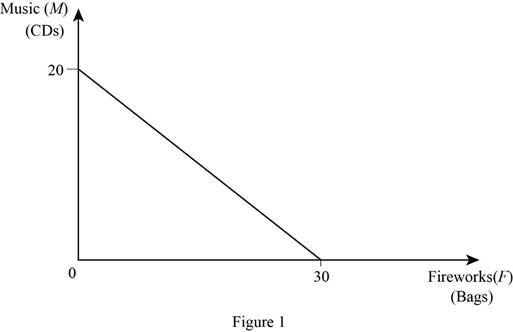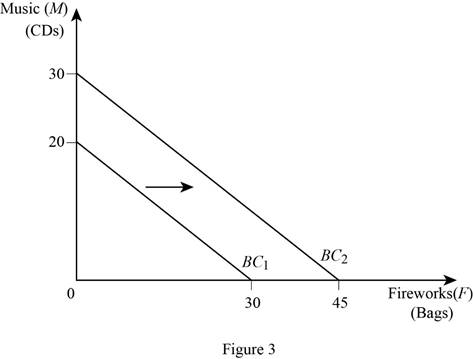
Concept explainers
(a)
The budget constraint.
(a)
Explanation of Solution
Budget equation can be written as follows:
Figure 1 illustrates the budget constraint with commodities, music, and fireworks.

In Figure 1, the horizontal axis shows the fireworks and the vertical axis shows the music. The income of the consumer is $240. The price of music is $12 per CD. Therefore, the consumer can purchase maximum $20 (240/12) music CDs. The price of the fireworks is $8 per bag. Therefore, the consumer can purchase maximum $30(240/8) bags. Hence, Figure 1 represents the budget constraint with music and fireworks.
Budget constraint: The budget constraint is a curve that describes the entire set of consumption bundles a consumer can purchase when spending all income.
(b)
The total amount spend on music.
(b)
Explanation of Solution
In Figure 1, the x-axis shows the fireworks and the y-axis shows the music. The income of the consumer is $240. The price of music is $12. If the consumer spends entire income on the music, then the number of music CDs that can be afforded is calculated as follows:
The consumer can afford 20 music CDs, if he spends the entire income on music. This is shown as point b in Figure 2.
(c)
The total amount spend on fireworks.
(c)
Explanation of Solution
The income of the consumer is $240. The price of the fireworks is $8. If the consumer spends entire income on fireworks, then the amount of fire bags that can be calculated as follows:
The consumer can afford 30 bags for fireworks, if he spends the entire income on it. This is shown as point d in Figure 2.
(d)
The half of the total income was spend on the fireworks and half of the income on the music.
(d)
Explanation of Solution
If the consumer spends half of the income on fireworks, then the amount of bags for fireworks can be calculated as follows:
Therefore, the consumer spends half of the income on fireworks 15 bags of fireworks, he can afford. This is shown by the point d in Figure 2.
If the consumer spends half of the income on music, then the number of music CDs can be calculated as follows:
Therefore, if consumer spends half of the income on music, he can afford 10 CDs. This is shown by the point d in Figure 2.
(e)
The slope of the budget constraints.
(e)
Explanation of Solution
Figure 2 illustrates the budget constraint with commodities, music, and fireworks.

The slope of the budget constraint is determined by the relative price of the two goods. Therefore, it can be calculated as follows:
Hence, the budget constraint is
Budget constraint: The budget constraint is a curve that describes the entire set of consumption bundles a consumer can purchase when spending all income.
(f)
The price of fireworks and the price of music.
(f)
Explanation of Solution
The price of fireworks is divided with the price of music.
Hence, the value of price divided with the price of music is
Budget constraint: The budget constraint is a curve that describes the entire set of consumption bundles a consumer can purchase when spending all income.
(g)
The new budget constraint.
(g)
Explanation of Solution
Figure 3 illustrates the new budget constraint with commodities, music, and fireworks.

In Figure 3, the horizontal axis shows the fireworks and the vertical axis shows the music. The new income of the consumer is $360. The price of music is $12. Therefore, the consumer can purchase maximum 30 (360/12) music CDs. The price of the fireworks is $8. Therefore, the consumer can purchase maximum 45 fire bags (360/8) with the new income. Hence, Figure 3 represents the budget constraint of music and fireworks at the new income level.
Budget constraint: The budget constraint is a curve that describes the entire set of consumption bundles a consumer can purchase when spending all income.
(h)
The number of fire bags and music CDs that can earned at new income level.
(h)
Explanation of Solution
The new income of the consumer is $360. Then, the new bundles of fireworks and music can be calculated as follows:
The consumer can afford 45 bags of fireworks, if he spends the entire income.
The consumer can afford 30 music CDs, if he spends the entire new income.
Consumption bundle: The consumption bundle is set of goods and services a consumer considers purchasing.
Want to see more full solutions like this?
Chapter 4 Solutions
Microeconomics

 Principles of Economics (12th Edition)EconomicsISBN:9780134078779Author:Karl E. Case, Ray C. Fair, Sharon E. OsterPublisher:PEARSON
Principles of Economics (12th Edition)EconomicsISBN:9780134078779Author:Karl E. Case, Ray C. Fair, Sharon E. OsterPublisher:PEARSON Engineering Economy (17th Edition)EconomicsISBN:9780134870069Author:William G. Sullivan, Elin M. Wicks, C. Patrick KoellingPublisher:PEARSON
Engineering Economy (17th Edition)EconomicsISBN:9780134870069Author:William G. Sullivan, Elin M. Wicks, C. Patrick KoellingPublisher:PEARSON Principles of Economics (MindTap Course List)EconomicsISBN:9781305585126Author:N. Gregory MankiwPublisher:Cengage Learning
Principles of Economics (MindTap Course List)EconomicsISBN:9781305585126Author:N. Gregory MankiwPublisher:Cengage Learning Managerial Economics: A Problem Solving ApproachEconomicsISBN:9781337106665Author:Luke M. Froeb, Brian T. McCann, Michael R. Ward, Mike ShorPublisher:Cengage Learning
Managerial Economics: A Problem Solving ApproachEconomicsISBN:9781337106665Author:Luke M. Froeb, Brian T. McCann, Michael R. Ward, Mike ShorPublisher:Cengage Learning Managerial Economics & Business Strategy (Mcgraw-...EconomicsISBN:9781259290619Author:Michael Baye, Jeff PrincePublisher:McGraw-Hill Education
Managerial Economics & Business Strategy (Mcgraw-...EconomicsISBN:9781259290619Author:Michael Baye, Jeff PrincePublisher:McGraw-Hill Education





